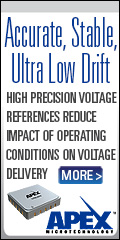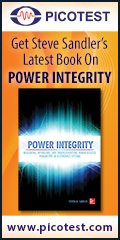
 |
 |

|
HOW2POWER EXCLUSIVE DESIGN ARTICLES 
|
Application-Specific FOM: Key To Choosing The Right MOSFET
by Sanjay Havanur and Philip Zuk, Vishay Siliconix, Santa Clara, Calif.
As key contributors of loss in power supply designs, power MOSFETs should be chosen carefully to yield the lowest loss for the given operating environment. But given the wide range of MOSFETs available today, it is not practical to experimentally evaluate all the devices in what would be considered a representative sample. Some designers choose the lowest RDSON device from a given set, which leads to a costly, suboptimal solution. Others rely on the popular figures of merit (FOMs), which are rooted in device design but are “blind” to the application. Instead of applying these generic formulas, designers need to do a simplified loss analysis at the system level and use it as the basis for device selection. This article illustrates the process for the common power factor correction (PFC) stage. However, the principle of loss-derived FOM is applicable to any topology.
Read the article…
|

Curves generated using a loss equation derived in
this article illustrate how selecting a PFC MOSFET
for lowest RDSON leads to suboptimal performance.
|


A procedure described by the author calculates
the thermal resistance required of an IGBT module
heatsink for a given set of operating conditions. |
Don’t Throw That Switch Yet! First Steps In A Large Inverter Design
by Paul Schimel, International Rectifier, El Segundo, Calif.
In our last segment, we discussed selecting the right IGBT module for the application. This included understanding the machine and its operating conditions, the IGBT module construction and the various IGBT ratings. With that as the foundation, the next logical step is to begin the inverter design. This work will take a look at the first three topics along that path. The first of these topics is the dc link, which requires that the capacitors, bussbars and interactions be carefully addressed. From this point the conduction and switching losses for the IGBT and FRED die are calculated with datasheet parametric values. Finally, this discussion segues into thermal design. Read the full story…
|

Automated Tools Improve Frequency Response In Switching Regulators
by Wanda Garrett, Texas Instruments, Santa Clara, Calif.
Many power supply design tools such as TI’s WEBENCH Power Designer include selection of compensation components. A few also include information to help assess a regulator’s stability, like estimated phase margin and/or electrical simulations showing Bode plot and/or transient response. What happens, though, if key schematic components have to be changed? How does the compensation change to match? Again, this varies by design tool. WEBENCH Power Designer includes a new Compensation Designer that makes it easy to update the compensation, and even improve it to gain faster response or better phase margin. This article will present a design example that demonstrates how to use Compensation Designer and the different options it offers for obtaining the desired transient response and stability.
Read the article…
|

WEBENCH Compensation Designer allows the
user to review existing compensation and stability,
and adjust compensation design to new targets. |

 |  |

FOCUS ON MAGNETICS 
Sponsored by Payton Planar Magnetics
A monthly column presenting information on power magnetics design, products, or related technology |

Determining Maximum Usable Switching Frequency For Magnetics In CCM-Operated Converters
by Dennis Feucht, Innovatia Laboratories, Cayo, Belize
Power converter size limitations require that magnetic components be made as small as possible while delivering the specified output power. The goal of this article is to develop design constraints for the optimum switching frequency that produces maximum core power transfer within acceptable power loss for converters operating deep in continuous conduction mode (CCM.) These include buck-boost (common inductor), flyback and Cuk-derived circuits. Read the full article… |

 |
 |

 |
|
|

Book Review  |

|
Comprehensive Text Explains SiC Technology From Ingots To Circuits
Fundamentals of Silicon Carbide Technology: Growth, Characterization, Devices and Applications, Tsunenobu Kimoto, James A. Cooper, IEEE Press-Wiley, ISBN 978-1-118-31352-7, glossy hardback, 538 pages, 2014
Reviewed by Dennis Feucht, Innovatia Laboratories, Cayo, Belize
This book is obviously about the new and emerging silicon carbide (SiC) semiconductor technology. While SiC (and also GaN) are emphasized in it as semiconductor materials, the book also has good general coverage of semiconductor electronics, beginning with crystal structure and developing through solid-state physics, device processes and processing, semiconductor diodes, BJTs, power JFETs, IGBTs, MOSFETs, MESFETs, conductivity-modulated FETs or COMFETs and other types. The devices are explained in gratifying detail, which is something that may also be said of the authors’ treatment of other topics ranging from wafer and device fabrication to defect characterization to device modeling and circuit applications.
Read the full story…
|

|

 — POWER PRODUCTS IN 3 IMAGES OR LESS — POWER PRODUCTS IN 3 IMAGES OR LESS 
|

Top Five Products And Demos Seen at APEC 2015
by David G. Morrison, Editor, HOW2POWER.com
An industry event as big and bustling as the Applied Power Electronics Conference (APEC) presents the attendee with access to vast amounts of technical information. There are many more presentations than one person can attend, and possibly more booths than one can visit during the three sessions when the exhibition is open. Nevertheless, attending this conference year after year—as many attendees do—left me with definite impressions of what might be new, different, or simply receiving more attention at this year’s event. In this article, I share some of my takeaways from the conference and the most intriguing products and demos I saw there.
More details…
 |


The PSMA notes two key drivers
for 3D packaging with embedded
substrate technology. One is the
trend toward higher power loads,
while the other is the performance
limiting effects of conventional
power packaging. |
In-depth Report Documents Embedded Substrate Technologies Available For Development Of Higher-Density Power Sources
At the Applied Power Electronics Conference last month in Charlotte, N.C., the Power Sources Manufacturers Association’s (PSMA) Packaging Committee published a report titled “Current Developments in 3D Packaging With Focus on Embedded Substrate Technologies.” A follow-up to the report on 3D packaging in power, which the PSMA published at last year’s APEC, this new report is considered the first comprehensive study on using embedded substrate technology for building power sources.
More details… |


|




|

INDUSTRY EVENTS  |
|
APEC Rap Session Ponders Progress, Prospects And Pitfalls For GaN Devices
By Kevin Parmenter, Contributor, Phoenix, Ariz
At this year’s Applied Power Electronics Conference (APEC 2015) in Charlotte, N.C., I was once again honored and privileged to moderate the rap session on wide-bandgap semiconductors. This is the third year this topic has been included among the three Tuesday night rap sessions and this was possibly the most popular of the three sessions as the room was filled to capacity with approximately 450 individuals. Free unlimited beer helped fuel the session and keep things lively. Although the wide-bandgap topic was being revisited, the treatment of the subject has been evolving. The theme this year was “Wide Bandgap Semiconductor Devices in Power Electronics —Who, What, Where, When and Why?” Moreover, the focus narrowed to address just gallium nitride (GaN) because there is a widely held belief that silicon carbide (SiC) is further along in finding its way and entering mainstream applications, especially in the higher voltage areas. The distinguished panelists this year included the usual representatives of semiconductor device manufacturers but also some representation from the power supply field with practicing design engineers in the group.
Read the article…
|
|
EM&CW Expo Shares Motor And Magnetics Knowledge—Including Last Chance to Take Colonel McLyman’s Course
For almost 40 years, the Electrical Manufacturing & Coil Winding (EM&CW) Expo, has provided the electrical industry forum for the technologies involving the materials and processes (including assembly, coil winding, and testing) for manufacturing electrical products. The 2015 edition of this conference and trade show will be held next month, May 13 and 14, in Milwaukee Wisconsin. The conference program features presentations from industry leaders on a range of topics related to the design and manufacturing technologies of coil assemblies, transformers, ac-dc motors, insulation materials and more. The EM&CW expo is co-located with the Electrical Wire Processing Expo and Critical Power 2015. The three events draw a total of approximately 3000 attendees. In addition to the conference program, the EM&CW Expo hosts a series of short courses including Colonel Wm. T. McLyman’s final offering of his course on “Practical Power Magnetics Design Techniques.”
Read the article…
|
 |
 |

IN MEMORY OF... |

On January 2, Ed Bloom, a very noteworthy figure in the field of power electronics passed away. Joe Horzepa has recounted some of Bloom’s accomplishments as an author, innovator and educator in a recent issue of the PSMA newsletter. Ed Bloom was a recipient of Power Electronics Technology’s Lifetime Achievement Award. For those who would like to learn more about Ed Bloom’s contributions to the field of power electronics, see the lengthy article published in the Sept. 2007 issue of Power Electronics Technology.
|

OTHER TOP POWER NEWS
|
|
 The plenary speakers and their talks for the upcoming ECCE 2015 conference in Montreal (Sept 20-24) have been announced. They include Don Tan of Northrop Grumman Aerospace Systems, who will speak on “A resilient dc microgrid for mission-critical space application;” David B. Durocher of Eaton, “A look Forward in Power Electronics Technologies following 50 Years of History in IEEE’s Industry Applications Society;” John W Palmour of Cree, “SiC Power Devices: Changing the Dynamics of Power Circuits from 1 to 30 kV;” and Gaétan Lantagne of Hydro-Québec Research Institute, “Advance in large-scale power system simulation for efficient energy conversion: from generation to customer services.” The plenary speakers and their talks for the upcoming ECCE 2015 conference in Montreal (Sept 20-24) have been announced. They include Don Tan of Northrop Grumman Aerospace Systems, who will speak on “A resilient dc microgrid for mission-critical space application;” David B. Durocher of Eaton, “A look Forward in Power Electronics Technologies following 50 Years of History in IEEE’s Industry Applications Society;” John W Palmour of Cree, “SiC Power Devices: Changing the Dynamics of Power Circuits from 1 to 30 kV;” and Gaétan Lantagne of Hydro-Québec Research Institute, “Advance in large-scale power system simulation for efficient energy conversion: from generation to customer services.”
 Texas Instruments is offering a new online library of white papers from its popular TI/Unitrode Power Supply Design Seminar series. Bob Mammano has reviewed and edited the list so that these 100+ papers are still relevant and valuable to power supply designers today. See TI Power Seminar White papers. Texas Instruments is offering a new online library of white papers from its popular TI/Unitrode Power Supply Design Seminar series. Bob Mammano has reviewed and edited the list so that these 100+ papers are still relevant and valuable to power supply designers today. See TI Power Seminar White papers.
|

 |
 |
|